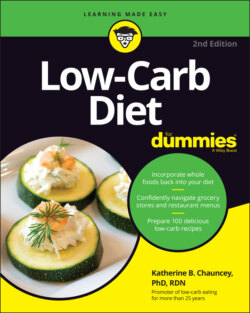Читать книгу Low-Carb Diet For Dummies - Katherine B. Chauncey - Страница 103
Determining your level of activity
ОглавлениеBeing active in today’s environment doesn’t come easy. Advances in the modern age have decreased the opportunities for exercise. Streaming services, video games, the Internet, smartphones, televisions, and so on have all pulled people indoors and gotten them sitting down. But your body is designed for physical output. You have large muscle groups in your legs, arms, back, chest, and abdomen, and smaller but very important muscles in your organ systems like your heart and lungs. If your muscles don’t get the workout they’re designed for, your whole body suffers.
The U.S. Department of Health and Human Services (DHHS) published its 2nd edition of Physical Activity for Guidelines for Americans in 2018. These recommendations for exercise are a mix of moderate-intensity aerobic activity at least 150 minutes up to 300 minutes per week and muscle-strengthening activity at least two days per week:
Moderate-intensity aerobic activity is any activity that gets your heart beating faster counts, such as, biking, swimming, gardening, or even walking the dog.
Muscle-strengthening activity is activity that makes your muscles work harder than usual such as lifting weight, wearing ankle weights, or working with resistance bands.
If those activities are more than you can do right now, then do what you can. Even 5 minutes of physical activity has real health benefits.
This recommendation stems from studies that indicate that physical activity is linked with even more positive health outcomes than researchers previously thought. The good news is that the exercise can be cumulative — you don’t have to get in 30 minutes or one hour all at once. The recommendation means you have to look for opportunities throughout the day to be more active. Taking the stairs, parking farther away, walking to a coworker’s desk rather than sending an e-mail, and walking short distances rather than driving a car are just some of the ways to build more exercise into your day. (You can find more on this in Chapter 22.)
Less than 30 percent of American adults are sufficiently active in their leisure time to achieve health benefits. Thirty-one million Americans aged 50 or older aren’t physically active at all. Even light activities such as standing or walking around the house are better than no activity at all. If you aren’t very active, start gradually and build up.
Look at the following categories of activity and mark the one that comes closest to describing how you spend your week. Unless you’re in the active or very active category, plan to up your exercise by one level:
Sedentary: Watching television, driving a car, sitting at work, playing video games, sewing, reading, writing, texting, or talking on the phone. No program of regular exercise.
Light exercise: Ironing, dusting, doing laundry, loading/unloading the dishwasher, preparing and cooking food, walking 2 miles per hour for 10 to 20 minutes three to five times per week.
Moderate exercise: Dancing, gardening, doing carpentry work, mopping/scrubbing, bicycling, jogging or walking at 3 miles per hour for 20 to 40 minutes three to five times per week.
Active: Heavy work, aerobics, tennis, skating, skiing, racquetball, brisk walking at 4 miles per hour for 30 to 60 minutes three to five times per week.
Very active: Bicycling 15 miles per hour, running 6 miles per hour, swimming, or participating in martial arts, for 45 to 60 minutes three to five times per week.
